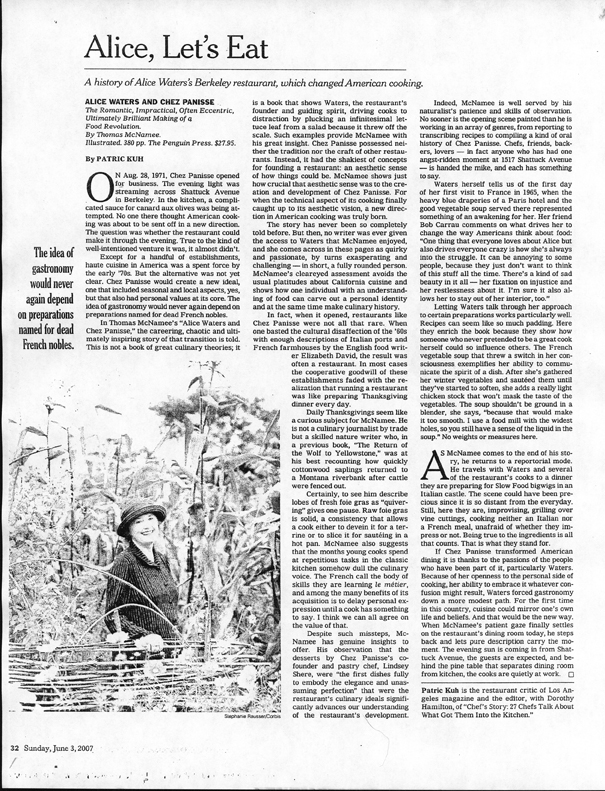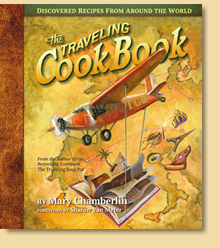
The Traveling Cook Book - by Mary Chamberlin
Enjoying Champagne with Master Sommelier Catherine Fallis
Alice, Let's Eat
A history of Alice Water’s Berkeley restaurant, which changed American Cooking.
The romantic, impractical, often eccentric, ultimately brilliant making of a food revolution.
By Thomas McNamee

Champagne, Caviar and the Pebble Beach Coast: A Report
I don't know many palates I trust more than Weekly food contributor Jeanne Howard's, so I was stoked when she agreed to gather a report from the American Institute of Wine and Food® Monterey Bay's annual Champagne and caviar tasting. (I'm more bathtub hooch and deviled egg than bubbly and fish eggs myself—and I was down south checking out the Big Sur Chanterelle Cook-off anyway. More on that soon.)
True to form, she delivers a textured and informative exploration of the famous pairing (Pete Tansill took the pictures).
Who wouldn’t want to be a member of an organization that exists simply to gather together good people, good food and good wine? Three late greats founded the American Institute of Wine and Food®: Robert Mondavi, Julia Child and Richard Graff (the latter of Chalone Vineyard fame).
The local chapter's seventh annual Champagne and Caviar Tasting, held on Sunday, Feb. 27, could have blown out the sensory circuits of less hardy mortals than those of us in attendance. It was heady just to contemplate the event at the Lodge at Pebble Beach. The 18th hole, 60 or so kindred foodie souls, six hard-to-find Champagnes from small grower-producers—this is artisanal, handmade Champagne—and five California caviars.
The afternoon began on the veranda, with informal conversation, appetizers, and Pierre Gimonnet et Fils 1er Cru Cuis Brut, N. V. Champagne, well-paired with a cerulean sky, azure sea and expanse of sun-blessed grass.
Indoors at round tables, it was infotainment at its best. Two key speakers regaled those of us who think learning about food is a rollicking good time. The bards were Jim Rollston of WineWise/The Vienna Wine Company based in Oakland, provider of the Champagnes, and Peter Struffenegger of Sterling Caviar, provider of the caviar.
Rollston is full of interesting bubbly stats. Here are a few to know:
- Only 3 percent of all imported Champagne is from small grower-producers who bottle Champagne from their own estate-grown grapes. The other 97 percent is from large houses.
- There are 19,000 growers in Champagne; only 2,000 make wine from their own grapes under their own name; and only 200 of those are imported to the U.S.
- The Champagne region comprises 80,000 acres of vineyards and is only one appellation. By contrast, Burgundy has 12,000 acres and 110 appellations. Monterey has 40,000 acres and nine American Viticultural Areas.
- There are three grapes permitted in Champagne: Chardonnay, Pinot Noir and Pinot Meunier. There are three primary growing regions: Montagne de Reims, Vallée de la Marne and Côte des Blancs.
The line-up of Champagnes was selected to showcase those three regions. The important take-home message was that just because you never heard of it doesn't mean it isn't good. In fact, the opposite is most likely true. You just need a tour guide like Rollston to light the way.
If you want to try the Champagnes mentioned here, some are offered in Carmel at Nielsen's Market, Andre's Bouch'e (both the wine market and the restaurant), the Cheese Shop, the Highlands Inn restaurants, Mundaka, and in Big Sur at Nepenthe and Sierra Mar.
If you like 100 percent Chardonnay (blanc de blancs), the freshest and lightest of Champagnes, I recommend the Varnier-Fannière Thomas Keller's Per Se in New York. "Cuvée St. Denis," Brut, N.V. made from rare old vines from a single vineyard, aged in stainless steel. It retails for $64, and FYI, this one is poured by the glass.
Rollston spewed more intriguing numbers: This Champagne is one of many cuvées made by Pierre Gimmonet, who produces 20,000 cases total for all of their cuvées. The world's largest Champagne producer, Moët & Chandon, produces 2.2 million cases annually (of which 200,000 cases are Dom Perignon).
A beautiful dish of four caviars provided by Sterling Caviar of Sacramento was served with the Varnier-Fannière. Struffenegger gave us a fascinating history of caviar, including its humble beginnings as a source of protein for the common everyday sustenance of the Russians who first enjoyed it hundreds of years ago. Once Europeans discovered it, it was only a century or so before caviar became scarce and expensive.
Sterling is one of the only American producers of premium farm-raised sturgeon caviar, and in this case the sturgeon is farmed sustainably and is native to the Pacific Ocean. The top-of-the-line caviar we tasted was their inky dark true sturgeon caviar that's comparable to Russian Osetra. Osetra is a different species than Beluga, and is usually considered second in quality only to Beluga. Beluga is now nearly impossible to get, and its importation is banned in the U.S., so it's rarely referenced by chefs or anyone else.
Each fish at Sterling is graded and labeled to ensure top quality because, as Struffenegger explained, no two fish are alike. Well, it was easy to discern the star of the show on our plate. Their product is rich, complex and nutty (like many of the guests). It's sold around the bay area (try Farm Fresh to You in S.F.'s Ferry Building), but it's most convenient for Monterey County residents to order online at sterlingcaviar.com. Thirty grams (just over an ounce) costs $62, $81 or $88, depending on the quality and maturity of the sturgeon.
In addition, we tried flavored caviars from San Francisco's Tsar Nicoulai. These "pioneers of sustainable California Caviar" have won a James Beard award and their products are a delight. They offer so many caviars and roes, you'll have to look at their website. We tasted, in order of my preference: Beet and saffron whitefish roe, truffled tiger-eye whitefish roe, and gold pearl trout roe. The first two are very smooth, the latter was the saltiest, but that's a good thing when it's combined with crème fraîche, grated egg whites, grated egg yolks, chopped shallots, and blini—as you like it. Two-ounce jars cost $23.50.
The flavored caviars are more in line with the budget of most foodies and are nothing to apologize for. They make a stunning presentation, are tasty and would certainly raise the status of any party.
Back to Champagne. For a good value, I highly recommend the René Geoffrey "Cuvée Expression" Brut, N.V. Retails for $50. The combination of 25 percent Chardonnay and equal parts Pinot Noir and Pinot Meunier, with aging in 10 percent neutral oak and 90 percent stainless steel conspired to give it a subtle color and delicious flavor.
This was accompanied by smoked salmon and a pate de foie de Volaille—the best fate a chicken liver could hope for—and made by AIWF chapter president Mary Chamberlin. Her decadently dense rendition with its multifaceted flavors was something to experience. I wonder if she'll give me the recipe.
Housemade salume was served with the elegant, dry Marc Hébrart "Cuvée de Réserve" Brut, N.V., produced from Mareuil-sur-Ay, the same village where the renowned Billecart Saumon is based. The Hébrart is 60 percent Pinot Noir and 40 percent Chardonnay, aged in stainless steel. You can try it at Mundaka in Carmel. Retails for $44.
We also enjoyed Marcona almonds, strawberries and brie with Chartogne-Taillet "Cuvée Ste.-Anne," Brut, N.V.—it's served by the glass at Nepenthe. Sixty percent Chardonnay, 40 percent Pinot Noir, aged in stainless steel. Retails for $43.
A special treat from a five-hectare vineyard, the Henri Billiot Rosé Brut, N.V., was accompanied by chocolates and fresh raspberries. The U.S. only gets 350 cases of this 75-percent Pinot Noir beauty.
What a ridiculously good deal of a feast. It cost $85 for members and $160 for nonmembers (which includes membership dues for a year). Apparently, only members were in attendance. That's because AIWF membership costs $75 per year for individuals. It's $125 for couples and friends are encouraged to join together.
Be part of a community of food and wine appreciators and reap the rewards—trust me, not a whiff of snooty 'tude was in the room.
